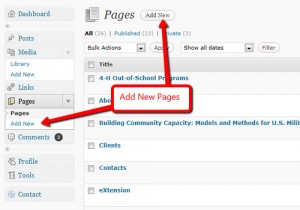 When you are starting any new business, whether it is online or a brick and mortar business, you need a website. There are lots of free options, but those are often unprofessional and take away from the reputation you want to build. Here are the steps to get a simple, easy website off the ground and running.
When you are starting any new business, whether it is online or a brick and mortar business, you need a website. There are lots of free options, but those are often unprofessional and take away from the reputation you want to build. Here are the steps to get a simple, easy website off the ground and running.
Table of Contents
Register a Domain
The first step in building a new website is to register a domain name, also called a URL (uniform resource locator). Your domain name is the thing that ends in .com, .org, .net, or any other of the 19 top level domains available (not including country specific top level domains).
For search engine, reputation, and ease of use purposes, the best domain name is always going to be yourcompanyname.com. That makes it easy and simple for a customer to find you. You may also consider registering domains like yourcompanyname.net and yourcompanyname.org to protect your brand from other people with similar names.
I register all of my domains using GoDaddy because it is the cheapest option that meets my needs. Some people don’t like GoDaddy, and there are lots of registrars to choose from. I always look to RetailMeNot for a coupon code when registering a new domain or renewing an old one.
On average, domain registration should cost $7-$12 per year.
Register for Hosting
Just like with domain registration, there are lots of options for hosting. While GoDaddy has its own hosting, I have heard some bad reviews, and I wanted to keep my hosting somewhere else so I had more control over the process.
I personally use Hostgator (use coupon code NB25PERCENT for 25% off any new plan) because it is fast and has great customer service. Other popular hosts include Dreamhost, Bluehost, and A Small Orange. Look here for the best cheap web hosing companies. Registrars companies like Media Temple have premium hosting at a premium price, but your site likely would not need that expense up front.
I pay 3 years up front for Hostgator to get a rate below $4 per month. That comes to less than $50 per year.
Once you setup your hosting account, use the DNS settings from your registrar to point your domain to your new host’s nameservers. It may take up to 48 hours for your new domain to propagate to DNS directories (essentially the internet’s white pages for where domain servers are located), but it is usually much faster.
Install WordPress
WordPress is a free CMS, content management system, that was originally intended for blogs. However, it is very robust and powerful and could be used for any number of purposes. For example, my flash mob business website is built on WordPress, but it is not a blog. I also used WordPress to build this non-profit site.
Most popular hosts have a one-click installation process for WordPress via CPanel or another hosting administration interface. The setup process with one-click installation take about 30 seconds.
Add a WordPress Theme
Once you install WordPress, you can add a premium theme (I use Genesis) or a free theme. To add a free theme, log into WordPress, click on Appearance >Themes via the menu, and then search for and add a theme you like best.
Add Content
Blog based sites use WordPress “posts” to bring the newest content to the front and center of their site. Most businesses prefer static “pages.” Adding a new page is easy, just hover your mouse over the +New button on the menu bar and click Page.
The WordPress editor is a WYSIWYG editor, or “what you see is what you get.” Whatever text and images you add to the page is what will show up when that page is viewed on your website.
Setup Your Professional Email Address
Last week, I walked you through setting up a professional email address for your business. No reason to re-write it, so visit this link for instructions on how to setup an email address using your domain.
Google What You Don’t Know
This is by no means an extensive guide. I self-taught myself everything I needed to know about web design by experimenting and reading online guides. If you have any questions, Google it. If you can’t find an answer, ask in the comments below.
If you have questions on setting up your first business website, just ask!




[…] @ Entrepreneurship Life writes How to Setup Your First Business Website – When you are starting any new business, whether it is online or a brick and mortar […]